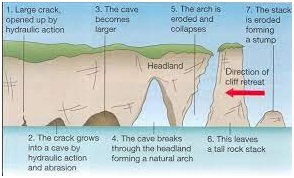Darwin's Arch in Galapagos collapses
- Posted By
10Pointer
- Categories
Geography
- Published
21st May, 2021
-
Context
The iconic Darwin's Arch in the Galapagos Islands has lost its top due to the natural erosion of the stone and now stands only two pillars.
About the Darwin’s Arch
- Darwin's Arch is a natural rock arch feature to the southeast of Darwin Island in the Pacific Ocean.
- The rock structure is 141 feet high, 230 feet long and 75feet wide.
- The arch sat on an irregularly shaped, rocky, submerged plateau which is nicknamed as ‘the theatre’.
- Darwin's Arch had a bridge-like appearance, which had been caused by erosion.
- The surrounding area of the Galápagos Islands was declared a World Heritage Site in 1978.
- The unique flora and fauna on the remote islands are famous in part for inspiring Charles Darwin's thoughts on evolution.
- The arch is also known for the wide variety of underwater life in its vicinity, including schools of hammerhead sharks.
- Reason behind the collapse: It is part of the natural process. The fall is due to exogenous processes such as weathering and erosion.
Some of the sea structures formed by Erosion
- Arch: An arch is produced by the waves erosion through a cliff. When a sea arch collapses, the isolated towers of rocks that remain are known as sea stacks.
- Cliff: A cliff is a vertical, or nearly vertical, rock exposure. Cliffs are formed by the processes of weathering and erosion. Sedimentary rocks most likely to form cliffs include sandstone, limestone, chalk, and dolomite. Igneous rocks such as granite and basalt also often form cliffs.
- Sea stack: A stack or sea stack is a geological landform consisting of a steep and often vertical column or columns of rock in the sea near a coast, formed by wave erosion.

|